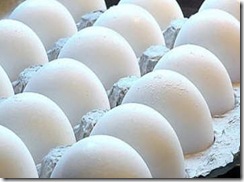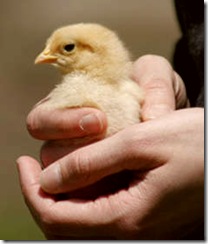Free Range or Cage Free: Is There a Difference?
 It all started with the egg – Eggland’s Best eggs. This was the first push for mainstream suppliers to address the problem that was being discussed and brought to light – that is the plight of the chicken, especially chemical chickens.
It all started with the egg – Eggland’s Best eggs. This was the first push for mainstream suppliers to address the problem that was being discussed and brought to light – that is the plight of the chicken, especially chemical chickens.
At that time, the inhumane treatment of chickens was being spotlighted in the news and concern was raised about eating eggs from those chickens.
What type of chickens are we talking about?
Chickens grown in crowded conditions that were fed hormones, antibiotics and questionable feed.
Eggland’s Best came to the rescue of Americans looking for an alternative. They promoted their eggs as ‘the best tasting’ and assured John Q public that there was no animal byproducts, hormones or antibiotics in the feed. In the beginning, there was only one variety of Eggland’s Best eggs: white ones with the EB logo stamped on each egg, certifying and branding each one as an Eggland’s Best egg!
 How else could you tell one white egg from another? How else would you tell that you got the real deal?
How else could you tell one white egg from another? How else would you tell that you got the real deal?
It was the ultimate experiment. "Would American’s pay 3-4 times as much for HEALTHY eggs as they would ‘regular’ eggs?"
The answer was…YES!
So, as other producers watched the Eggland experiment unfold, more products were added to the market…and succeeded. Then came brown eggs, organic eggs, cage free eggs and free range eggs.
Of course, what else came was competition.
Markets started to show products from other national and local producers. These local producers could deliver a FRESHER product at the same cost or cheaper. Many had superior flavor.
The local producers also added products to their lines that had no competition from the big boys. An example of this is raw milk. Another is high cream/low pasteurized milk and yogurt.
You should taste the eggnog one local supplier makes. It’s da bomb; thick, creamy, filling…so very delicious and satisfying- absolutely the best I’ve ever had, bar none. The only bad thing about it is they do not produce it year round.
Almost everyone likes to support the local producer, especially if the quality is similar or superior to a national one.
That’s what’s happening here in Michigan.
Not only do we have local farmers supplying free range and organic eggs, they are also supplying chemical, hormone and antibiotic free chicken, beef and cheeses.
are also supplying chemical, hormone and antibiotic free chicken, beef and cheeses.
But with more suppliers coming into the market comes CONFUSION….some of which is intentional.
When Eggland’s Best came to prominence, almost everyone assumed that it was an organic product. When other competitors started to specify their products as organic or free range, Eggland’s Best introduced these categories to their line, and added a new one – cage free.
So, I’m confused. What’s the difference between free range and cage free? If you look at the faces of people reading the egg cartons, I’m not the only one wondering what the producers were thinking…and why the introduction of cage free.
Well, it appears that organic free range eggs are the pinnacle of the commercial grown egg- the best egg that you can buy in the supermarket. Amish eggs, open range and pastured eggs are the best I’ve eaten, period.
So, what is cage free? Is it just a marketing ploy to allow for another high priced product that might be no different from the grade level below it?
The cartons do not tell what the difference is. So I looked it up.
"Cage free" is a commercial designation, not one by the USDA. It just means that the chicken were not kept in battery cages, as this NY Times article indicates. It may be a more humane way of growing chickens and producing eggs, but not much else. I’m not sure why anyone would pay 3 times more for a dozen of eggs if the only designated difference is ‘cage free’.
"Free range" has a different meaning to the USDA than what most people think. When you think of free range, the picture of a open pasture full of chickens comes to mind – reminiscent of pastured poultry or chicken tractors. But this is far from the truth.
By definition per the USDA, free range only means that the chickens have access to the outside, not that they are ‘grown’ outside.
Here’s a quote from USDA trade guidelines for the free range designation (section 10.5, page 13):
" The birds are raised in heated and air-cooled growing houses with access to the outdoors…"
That doesn’t give me visions of healthy.
Just having access to the outdoors, not any mandatory time spent outdoors, is enough to label eggs ‘free range’…and increase the price 3 times over regular eggs.
Add the ‘organic’ designation and you can charge top dollar for them.
Interesting enough…the Amish don’t call theirs either…just organic eggs. If you buy directly from the Amish, they are just called… "eggs". You just assume since you are buying from the Amish, they are keeping to the old ways of growing chickens and producing eggs.
At least you don’t have to be concerned with them giving the chickens hormones or antibiotics. And…depending on how many you buy, the price for a dozen is much less than either the organic, free range or cage free carton of eggs you get in the supermarket.
And is most definitely fresher.
So…now it’s time for you to decide. When you go to the store and are trying to decide between organic free range eggs and organic eggs, the price tag may be the only thing really differentiating the two.
Tags: cage free eggs, free range eggs, organic eggs, pastured poultry
Comments (130)